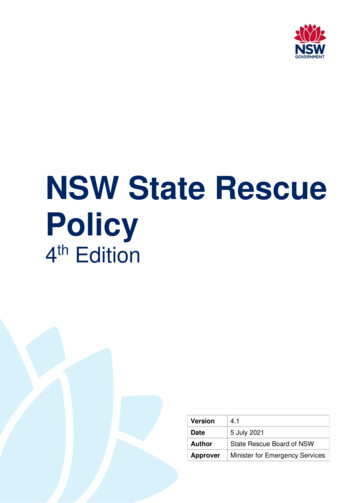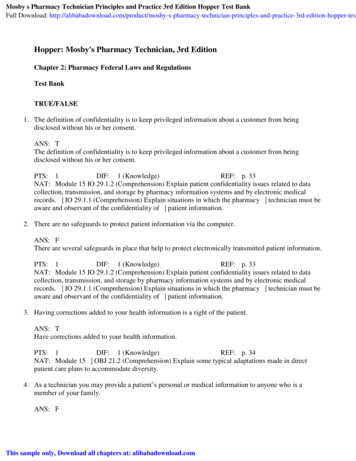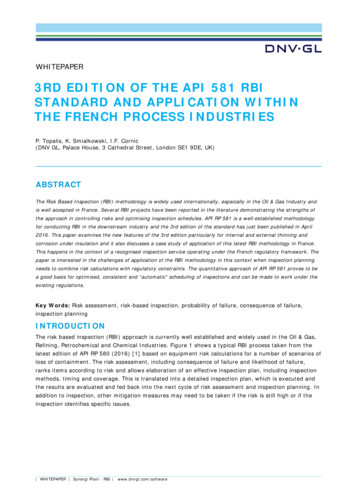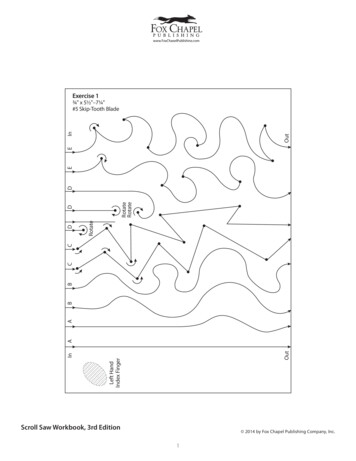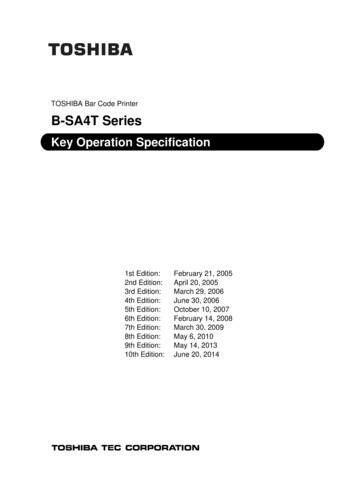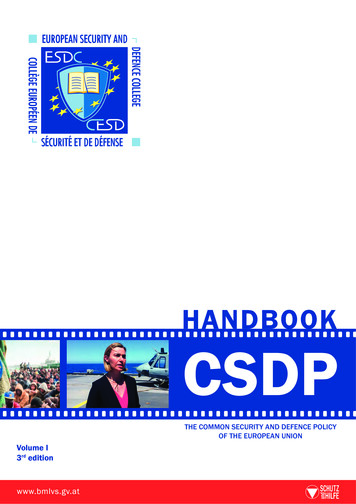
Transcription
HANDBOOKCSDPTHE COMMON SECURITY AND DEFENCE POLICYOF THE EUROPEAN UNIONVolume I3rd edition
HANDBOOK ON CSDPTHE COMMON SECURITY AND DEFENCE POLICY OF THE EUROPEAN UNIONThird editionedited byJochen Rehrlwith forewords byH.E. Federica MogheriniHigh Representative of the Union for Foreign Affairs and Security Policyand Vice President of the European CommissionH.E. Hans Peter DoskozilFederal Minister of Defence and Sports of the Republic of AustriaH. E. Christoforos FokaidesMinister of Defence of the Republic of Cyprus
This document has been produced with the financial assistance of the European Union andthe Ministry of Defence of the Republic of Cyprus.Disclaimer:Any views or opinions presented in this handbook are solelythose of the authors and do not necessarily represent those of theEuropean Union, the Austrian Ministry of Defence and Sports or the Cypriot Minisrty of Defence.Publication of the Federal Ministry of Defence and Sports of the Republic of AustriaEditor: Jochen RehrlIdea and concept: Jochen RehrlPublished by: Directorate for Security Policy of the Federal Ministry of Defence and Sports of the Republic of AustriaPicture credits for the front page: European Union, EUMM Georgia, EUNAVFOR MED, European Security and Defence CollegePrinted and bound by: Armed Forces Printing Centre, Vienna/Austria, 2017(16-03300 16-03527) Federal Ministry of Defence and Sports of the Republic of Austria and Jochen RehrlProject Number: 2016.7906Linguistic versionENMedia/VolumePaper/Volume 01PDF/Volume 01Catalogue 5/764888Printed according to the Austrian Ecolabel for printed matter,Austrian Federal Ministry of Defence and Sports/Armed Forces Printing Centre, UW-Nr. 943
CONTENTS1 COMMON SECURITY AND DEFENCE POLICY1.1.1.2.1.3.1.4.History and Development of CSDP (Gustav Lindstrom). 16The EU Global Strategy. 20Factsheet: European Defence Action Plan. 25Graphic: The EU in a contested world. 26Analysing the EU Global Strategy on Foreign and Security Policy (Sven Biscop). 28How to implement Strategy – Implementation Plan on Security and Defence(Raphaela Engel). 352 ROLES AND RESPONSIBILITIES2.1.2.2.2.3.2.4.2.5.2.6.The European Union and CSDP – State of Affairs (Gabor Iklody). 42The European Council and CSDP (Luis Amorim). 462.2.1. The European Council. 462.2.2. The Council of Ministers of the European Union . 50The Role of the European Commission in CSDP (Diego de Ojeda). 55The Role of the European Parliament in CSDP (Jérôme Legrand). 58The EEAS and its Crisis Management Component (Arnold Kammel). 66EEAS Crisis Response Mechanism (Pedro Serrano). 733 CSDP MISSIONS AND OPERATIONS3.1.3.2.3.3.3.4.How to Launch a CSDP Mission or Operation (Ana Isabel Xavier and Jochen Rehrl). 78Challenges of Military Operations and Missions (Georgios Tsitsikostas). 83Challenges for Civilian CSDP Missions (Kate Fearon and Sophie Picavet). 89Excursus: EUFOR ALTHEA (Friedrich Schrötter). 974 EVOLVING SECURITY CHALLENGES4.1.4.2.4.3.4.4.4.5.Migration and CSDP (Jochen Rehrl). 104Factsheet: A European Border and Coast Guard. 112Counter-Terrorism and the CSDP (Birgit Löser). 114Cyber Security/Defence and CSDP (Jan Peter Giesecke). 119Hybrid Threat and CSDP (John Maas). 125Critical Infrastructure Protection (Herbert Saurugg). 1313
5 CROSS-CUTTING CSDP ISSUES5.1.5.2.5.3.5.4.Gender and Women, Peace and Security in CSDP (Taina Järvinen). 140Human Rights and CSDP (Taina Järvinen). 143Rule of Law and CSDP (Daphne Lodder). 146The New EU-Wide Strategic Framework to Support SSR(Karin Gatt Rutter and Gianmarco Scuppa). 1526 CFSP AGENCIES6.1.6.2.6.3.EU Institute for Security Studies (Antonio Missiroli). 156The European Union Satellite Centre (Pascal Legai). 160The European Defence Agency (Jorge Domecq). 1647 COOPERATION AND COLLABORATION7.1.7.2.7.3.CSDP and Partners (Clara Ganslandt). 170Internal-External Security Nexus – Strengthening Ties Between CSDPand FSJ Actors (Michel Savary). 178The Seurity and Development Nexus (Clément Boutillier). 1848 CAPABILITY DEVELOPMENT8.1.8.2.8.3.EU Capability Development (Herbert Sailer). 194Strenghtening EU Defence with Multinational Cooperation (Sabine Mengelberg). 206European Defence Deployable Capabilities (Christos Malikkides). 2099 TRAINING AND EDUCATION9.1.9.2.9.3.9.4.4The CSDP Training Policy (Horst Koukhol). 214The European Security and Defence College (Dirk Dubois). 217Military Erasmus – European Initiative for Young Officers inspired by Erasmus(Harald Gell). 220The Positive Side Effects of Training –The Security Policy Dimension (Jochen Rehrl). 223
LIST OF TCHGC-IEDCIPCivComAArmed ForcesCommittee on Foreign Affairs (EP)Autonomous Knowledge UnitAfrican Union Mission in SudanAfrican Union Mission in SomaliaAfrican Peace FacilityASEAN Regional ForumSecure Rapid General Alert SystemAssociation of Southeast AsianNationsAsia-Europe MeetingAfrican UnionCMCCMPDBBelgium, the Netherlands, LuxembourgBattle GroupBudgetary Impact StatementCPCCCComprehensive ApproachCentral African RepublicConfidence-Building MeasureCapacity Building in Support ofSecurity and DevelopmentCivilian Capability DevelopmentPlanCreative DestructionCyber DefenceCapability Development PlanCyber Defence Policy FrameworkCentral European Defence Co operationComputer Emergency ResponseTeamCivilian Headline GoalCounter Improvised ExplosiveDeviceCritical Infrastructure ProtectionCommittee for Civilian Aspects ofCrisis PCTCT/P-CVECVECrisis Management ConceptCrisis Management and PlanningDirectorateCouncil of EuropeCommanderConcept of OperationsCoordinating Office for Palestinian Police Support (EUPOL)Committee of Permanent Representatives of the Governments ofthe Member StatesStanding Committee on Operational Cooperation on InternalSecurityCivilian Planning and ConductCapabilityConflict Prevention and PeaceBuildingCrisis Response Mechanism(EEAS)Cyber SecurityCommon Security and evention andCountering Violent ExtremismCountering Violent ExtremismDDCIDevelopment CooperationInstrumentDDoSDistributed Denial-of-Service(cyber attack)DDRDisarmament, Demobilisationand ReintegrationDG DEVCO Directorate-General for International Cooperation and DevelopmentDG NEAR Directorate-General for Neighbourhood and Enlargement NegotiationsDIFDefence Industry Factories5
DOTMLPF-I Doctrine, organisational, training/exercise, material, leadership,personnel, facilities and interoperabilityDrDoctorDSGDeputy PEPCESAESDC6EExecutive Academic BoardEmbedded Advisory TeamsEuropean Border and CoastGuard Agency (former FRONTEX)European CommissionEuropean CommunityEuropean CouncilECOWAS Mission in GuineaBissauEconomic Community of WestAfrican StatesEuropean Credit Transfer andAccumulation SystemEuropean Defence AgencyEuropean Defence Action PlanEuropean Development FundEuropean Defence Technologicaland Industrial BaseEuropean External Action ServiceEuropean Economic CommunityEuropean Gendarmerie ForceEuropean Global StrategyEuropean Instrument forDemocracy and Human RightsEuropean Institute forGender EqualityeLearning, Cyber Security andInternet PerformanceEuropean Neighbourhood PolicyEuropean Neighbourhood andPartnership InstrumentEuropean ParliamentEuropean Political CooperationEuropean Space AgencyEuropean Security and DefenceCollegeESDIEuropean Security and DefenceIdentity (NATO)ESDPEuropean Security and DefencePolicyEuropean Security StrategyESSEuropean UnionEUEU INTCEN EU Intelligence and SituationCentreEU MSEU Member StateEU Border Assistance MissionEUBAMEuropean Union Capacity BuildEUCAPing MissionEuropean Council ConclusionsEUCOEUDELEU DelegationEUFOREU ForceEUGSEU Global Strategy on Foreignand Security PolicyEUISSEU Institute for Security StudiesEUJUSTEuropean Union Rule of LawMissionEULEXEuropean Union Rule of LawMissionEUMAMEuropean Union Military Advisory MissionEUMCEU Military CommitteeEUMCWG EU Military Committee WorkingGroupEUMMEU Monitoring MissionEUMSEU Military StaffEUNAVFOR EU Naval ForceEUPOLEU Police MissionEUREuro (currency)EUROJUST European Union Agency forCriminal Justice CooperationEUROPOL European Union Agency for LawEnforcement CooperationEUROSUR European Border SurveillanceSystemEUSREU Special RepresentativeEUTMEU Training MissionFACFCASFForeign Affairs CouncilFragile and Conflict-AffectedStates
GIIGSCH.E.HGHoAHQHRHR/VP orHRVPHTFIAICSIcSPICTIMDForce HeadquartersFramework Participation AgreementEuropean Agency for the Management of Operational Cooperationat the External Borders of theMember States of the EuropeanUnion (see EBCG)Freedom, Security and JusticeFree Trade AgreementForeign Terrorist FightersGGroup of TwentyGroup of SevenGeneral Affairs CouncilGender Action Plan (EU)Gulf Cooperation CouncilGlobal Counter-terrorism ForumGeospatial IntelligenceGeneral Framework Agreementfor PeaceGender Inequality IndexGeneral Secretariat of the Council(EU)HHis/Her ExcellencyHeadline GoalHorn of AfricaHeadquartersHigh Representative (for ForeignAffairs and Security Policy)High Representative andVice-PresidentHeadline Goal Task ForceIIntegrated ApproachIndustrial Control SystemInstrument contributing to Stability and PeaceInformation and CommunicationTechnologyInitiating Military DirectiveIMINTINIINSCImagery IntelligenceOwn-initiative ReportInstrument for Nuclear SafetyCooperationINTELIntelligenceINTERPOL International Criminal PoliceOrganisationInternet of ThingsIoTInstrument for Pre-accession AsIPAsistanceIPCRIntegrated Political Crisis ResponseIntegrated Situational AwarenessISAAand AnalysisISBNInternational Standard BookNumberISSInternal Security Strategy (EU)ITPsInstructions to PartiesJCMJHAJSSRJJoint Consultation MeetingJustice and Home AffairsJustice and Security Sector ReformLCCLegAdLoALOTLtGenLULLOT Coordination CentreLegal AdvisorLevel of AmbitionLiasion and Observation TeamLieutenant GeneralLearning UnitMMAMine ActionMajGenMajor GeneralMDManaging Director (EEAS)MDGMillennium Development GoalMERCOSUR Mercado Común del SurMFAMinistry of Foreign AffairsMIAMinistry of Internal AffairsMISCAAfrican-led International SupportMission in the Central AfricanRepublic7
MMAMOD(S)MOJMPCCMREMSMSCNATOMonitoring, Mentoring and AdvisingMinistry of Defence (and Sports)Ministry of JusticeMilitary Planning and ConductCapabilityMine Risk EducationMember StatesMunich Security ConferenceNorth Atlantic Treaty OrganisationNNHQNATO HeadquartersNORDEFCO Nordic Defence CooperationNRFNATO Response d CrimeOrganisation for Joint ArmamentCooperationOfficial Development AssistanceOrganisation for EconomicCooperation and DevelopmentOperation HeadquartersOperation CommanderOperation PlanOrganisation for Security andCooperation in EuropeOpen Source IntelligencepMSParticipating Member StatesPolAdPolitical AdvisorPRISMProfPSCPrevention of conflicts, Rule oflaw/security sector reform, Integrated approach, Stabilisation andMediationProfessorPolitical and Security CommitteeQMVQQualified Majority tory ActionProgramme of support forenhanced security in the Moptiand Gao regions and for the management of border areasPre-deployment TrainingPermanent Structured CooperationPolitical Framework for CrisisApproachPartnership for Peace (NATO)Partnership InstrumentPolitico-Military g Party of Foreign Relations CounsellorsRevisionRule of LawRemotely Piloted Aircraft SystemResearch, Technology Development and InnovationSSituational AwarenessSafe and Secure EnvironmentSatellite CentreSteering CommitteeSupervisory Control and DataAcquisitionDirectorate for Security Policy andConflict PreventionSubcommittee on Security andDefence (EP)Single European Sky Air TrafficManagement ResearchSecretary-GeneralSingle Intelligence Analysis CapacityEU Joint Situation CentreSmall and medium-sized enterprisesSecurity Operation CentreStatus of Forces AgreementStatus of Mission AgreementStandard Operating ProceduresStatement of Requirements
SSRSecurity Sector ReformSSTSpace Surveillance and TrackingSTRATCOM Strategic )V4VPVUCAWPSYESTTroop Contributing NationTreaty on European UnionTreaty on the Functioning of theEuropean UnionWorking Party on TerrorismUUnited KingdomUnited NationsUnited Nations General AssemblyUnited Nations Interim Administration Mission in KosovoUnited Nations Security Council(Resolution)United States (of America)VVisegrad GroupVice-President (of the EuropeanCommission)Volatility, Uncertainty, Complexity and AmbiguityWWomen, peace and securityYYearbook of European Security(EUISS)9
The need for a strong European Union hasnever been perceived so acutely as it is today.None of our Member States – alone – has theresources to stabilise fragile countries around ourborders, prevent the next refugee crisis, or createa safe environment for our economies to thrive.But as a Union of almost half a billion citizens,we are the first economic and trade power in theworld, the largest investor in development cooperation and humanitarian aid, and a global security provider.More and more, our partners around the worldsee us as an ‘indispensable power’ to build a morecooperative world order. The citizens and the governments of Europe, on their side, increasinglyrealise that European security, too, can only beguaranteed through a collective effort.It is in this context that I presented a GlobalStrategy for our foreign and security policy, anda package of concrete measures to move towardsa true Union of security and defence – a package that has now been endorsed by the EuropeanCouncil. We are finally building the conditionsto make full use of the tools at our disposal. TheGlobal Strategy and its implementation processaims precisely at that goal.Of course, we do not start from scratch. Ourmissions and operations around the world are awell-established reality. I could not imagine ourexternal action without Operation Sophia, fighting against human traffickers and saving lives in10EC - Audiovisual Service/Jennifer JacquemartFOREWORDthe Mediterranean; or without Operation Atalanta, which has successfully contained piracy offthe Horn of Africa; or the EUCAP Sahel missions, supporting local security forces in one ofthe most strategically important regions in ourwider neighbourhood.To preserve these successes and expand ourCommon Security and Defence Policy, we mustprovide our personnel with the best training andeducation. The European Security and DefenceCollege, supported by Member States’ commitments, provides first-class training to the EUcivilian and military staff, by addressing real-timetraining needs and requirements. This handbook gives an excellent overview of our CSDP.Recognised experts from Europe provided theirexpertise to contribute to this new edition, whichwas again published by the Austrian Ministry ofDefence and Sports.Only if we understand our strength – whatwe do best and what we could do better – willwe be able to reform our Union. In a momentwhen the very essence of the European project isbeing questioned, we need to demonstrate thatour Union can truly deliver on our citizens’ needs.Heading towards a real European Union of security and defence has never been so important.Federica MogheriniHigh Representative of the Unionfor Foreign Affairs and Security Policy
Ricardo HerrgottFOREWORDThe Common Security and Defence Policy is the‘business card’ of the European Union in crisis andconflict areas. When this policy field became operational in 2003, its main goal was to strengthen thecrisis management toolbox using military and civilian means. Fourteen years later, CSDP plays a leading role within the comprehensive approach of theEuropean Union, complementing other tools suchas development cooperation, financial support anddiplomatic and conflict prevention measures.With over 30 missions and operations aroundthe world, the European Union has proven to be aglobal and reliable actor. The Union and its Member States did not reinvent the wheel, but ratherimplemented good practices, learned lessonsand followed a value-based crisis managementapproach. Most of the missions and operations canbe seen as part of the broader picture of securitysector reform, which bring only a few ‘quick wins’.However, the focus is on long-term objectives.Security is a field that is constantly developing:challenges emerge, new tasks are allotted, priorities shift. Taking this assessment as a startingpoint, the strategic guidance offered by the recentEU Global Strategy, which aims to be a ‘GlobalStrategy to promote our citizens’ interests’, is ofutmost importance. According to the latest Eurobarometer survey, citizens are mainly interestedin two topics at the European level: tackling themigration challenge and countering the threatof terrorism. In order to maintain our credibility within the EU territory as well as outside ofit, the EU must find ways to convince citizens ofthe added value of working together at the European level, of pooling our resources and of stand-ing together when our way of life is threatened.The challenges faced by European countries todaycannot be solved on a national, stand-alone basis.The European Union is tasked with presentingsolutions. In the current implementation phase ofthe Global Strategy, we have to ‘think global, andact European’.The European Union, its Member States andits citizens must regain their common vision. Thiscommon vision can be found by reinforcing ourcommon European security culture, allowing usto benefit from the joint situational awarenessthat will lead to common action and a unifiedEurope in a better world.The European Security and Defence College(ESDC) has a leading role in establishing such asecurity culture. With more than 12,000 alumni,the ESDC has demonstrated its tremendous valueto the European project in the past. Training andeducation is the foundation of a successful Common Security and Defence Policy, hence the basisfor a reliable European ‘business card’.I am happy that Austria is the main supporterof the ESDC. This handbook series is an exemplary means of transferring knowledge, sharingbest practices and stimulating discussions onCSDP-related subjects. I wish the readers of thispublication all the best in their professional work,good luck in future deployments in CSDP missions and a pleasant experience reading the articlesby various European experts on security issues.Hans Peter DoskozilFederal Minister of Defence and Sportsof the Republic of Austria11
Ministry of Defence/CyprusFOREWORDToday, more than ever before in its history,the European Union is faced with unprecedentedsecurity threats that challenge the very essence ofEuropean civilisation and our open democraticsocieties. It is therefore high time for decisionsthat respond to these challenges efficiently andcomprehensively, coming up to the expectationsof our citizens.In this context, the EU Global Strategy sets outa new level of ambition for a stronger and saferEurope. Furthermore, the Implementation Planon Security and Defence, as well as the EuropeanDefence Action Plan, constitute decisive stepstowards an enhanced European defence and security architecture.Located in a geostrategic region of great instability, Cyprus is firmly committed to promotingthe collective security of Europe in these demanding times that call for common action.12This new level of ambition for CSDP necessitates the promotion of a common security anddefence culture based upon our shared values,ideals and security interests. Investing in systematic education and training is a prerequisite forachieving this goal. In this regard, the role of theEuropean Security and Defence College is crucial.Cyprus actively supports the prominent workand the educational initiatives of the ESDC,including the publication of the present Handbook.I am convinced that it will be an invaluabletool for decision-makers and all those who wantto deepen their understanding and knowledge ofthe Common Security and Defence Policy, andwill thus contribute to advancing the wider goalof a common defence culture.Christoforos Fokaides,Minister of Defenceof the Republic of Cyprus
Ministry of Defence/AustriaPREFACEIn 2017, seven years after the first editionof the ‘Handbook on CSDP’, it is time for acompletely revised version of the most popularESDC publication in the handbook series.Federica Mogherini is the third High Repre sentative of the European Union for ForeignAffairs and Security Policy and the second womanto hold this position. She has brought newmomentum to the Common Foreign and Securit y Policy, which has been driven by numerouschallenges both inside and outside the EuropeanUnion. Migration, terrorism and cyber securitycan be included within the most demandingissues that require ‘united action’ and a ‘strongerEurope’.Only six months after its publication, the EUGlobal Strategy is already the reference document for all foreign and security-related workwithin the EU institutions and the EU Member States. Security and defence form the cornerstones for new developments which shouldhelp address the challenges ahead. Strategies andaction plans have been drafted which will helpensure that that there is an even more effectiveand efficient Common Security and DefencePolicy for the future.However, changes were not only evident onthe European stage. The editorship of this handbook is also new. In the past, I co-edited thishandbook with Mr. Hans-Bernhard Weisserth,who retired in spring 2015 after several years ofsuccessful service for the European Union as thefirst Head of the European Security and DefenceCollege (ESDC).Fortunately, the Austrian Ministry of Defenceand Sports as well as the new Head of the ESDC,Mr. Dirk Dubois, remained committed to thepublication of this handbook. With Cyprus,the handbook series welcomed a new partner onboard.In this preface, I would like to repeat what Ihave already stated in previous editions of thehandbook, namely that such a publication canonly be possible with the help of a team of ableand willing experts, who are prepared to sharetheir experience and expertise. Saying ‘ThankYou’ is only a small sign of appreciation fortheir tremendous contribution, not only in thetransfer of knowledge but also in facilitating theestablishment of a Common European SecurityCulture.I would, in particular, like to thank: LtGen Günter Höfler, Head of the AustrianMilitary Representation in Brussels and histeam; MajGen Johann Frank, Defence Policy Director of the Austrian Ministry of Defenceand Sports and his Directorate for SecurityPolicy; Mr Oliver Rentschler, Deputy Head of theCabinet of Ms Federica Mogherini;13
Mr Gabor Iklody, Director of the Crisis Management and Planning Directorate; the English editing service of the GeneralSecre tariat of the Council; Mr Roman Bartolomay, Head of the AustrianPrinting Shop and his team, in particular MrLastly, I am more than grateful for the supportof my family, my wife Bernadeta and my children Julia and Maximilian. I would like to thankthem for their patience and understanding, inparticular during the Christmas season.I hope that the third edition of the ‘Handbookon CSDP’ will meet your expectations and willagain serve as a reference document for the present and future experts on the Common Securityand Defence Policy.Jochen RehrlJochen Rehrl (ed.): Handbook FoR dECISIon MakERSJochen rehrl, Galia Glume (eds): Handbook on MISSIonS and operatIonS my colleagues in the ESDC Secretariat: MrMario Marmo, Ms Irene Eich, Mr SymeonZambas, Ms Charlotta Ahlmark, Mr OvidiuSimina and Ms Ewelina Miazga.-3-902275-42-4HandbookHandbookMISSIonSand operatIonSFoRdECISIon MakERSthe CommoN SeCurIty aNd defeNCe PolICyof the euroPeaN uNIoNthe CommoN SeCurIty aNd defeNCe PolICyof the euroPeaN uNIoNISBN: 978-3-902275-35-6TheTheThe latest handbook onHANDBOOK ON CSDPMISSIONS AND OPERATIONSHANDBOOK FORDECISION MAKERSMIGRATION –HOW CSDP CAN SUPPORTtargets the personnel deployed in the field. It describes thestructures and procedures witha focus on the implementationof the mission mandate. It summarises the principles and guidelines of CSDP engagements.targets the strategic and operational leadership level for CSDPengagements abroad. It providesan overview of the Common Security and Defence Policy. Thehandbook provides some skillsfor decision makers, such as negotiation techniques, mediationand conflict analysis.was published in the aftermathof a high-level conference on13 September 2016 in Brussels.It includes articles from recognised European academics andpractitioners as well as a compendium of various factsheetson migration from the EuropeanCommission, the European Parliament and the European External Action Service.Jochen Rehrl, Galia Glume (ed.):Handbook on missions andoperations. Vienna, 2015.ISBN: 978-92-95201-07-114Jochen Rehrl (ed.): Handbook forDecision Makers. Vienna, 2014.ISBN: 978-92-95201-09-5Sven Biscop, Jochen Rehrl (ed.):Migration – How CSDP can support. Vienna, 2016.ISBN: 978-3-902275-45-5
1COMMON SECURITY ANDDEFENCE POLICY15
HANDBOOK ON CSDP1.1. HISTORY AND DEVELOPMENT OF CSDPPhoto: Austrian Armed Forcesby Gustav LindstromThe success story of the Common European Security and Defence Policy started at the informalEuropean Council in Pörtschach in October 1998 during the Austrian Council Presidency:In the picture, 1st row: António Guterres (PT), Tony Blair (UK), Jacques Santer (EU), Martti Ahtisaari (FI),Viktor Klima (AT), Jacques Chirac (FR), Gerhard Schröder (DE), Paavo Lipponen (FI), Lionel Jospin (FR);2nd row: Jean-Claude Juncker (LU), Bertie Ahern (IE), Costas Simitis (GR), José Maria Aznar (ES),Göran Persson (SE), Jean-Luc Dehaene (BE), Poul Nyrup Rasmussen (DK), Massimo D’Alema (IT),Wim Kok (NL).The origins of Europe’s security and defencearchitecture can be traced back to the years following World War II. Beginning in the late 1940s,several initiatives facilitated increased cooperationacross Europe. Examples include the signing ofthe Brussels Treaty (1948) – sowing the seeds fora Western European Union – and the creationof the European Coal and Steel Community in1951, placing strategic resources under a supranational authority.In the late 1960s, the European Community(EC) began to explore ways to harmonise members’ foreign policies. At The Hague Summit, heldin December 1969, European leaders instructedtheir foreign ministers to examine the feasibility of closer integration in the political domain.16In response, the concept of European PoliticalCooperation (EPC) was presented in the October1970 Davignon Report. The report defined EPC’sobjectives, including the harmonisation of positions, consultation and, when appropriate, common actions. It also listed specific processes, suchas six-monthly meetings of the Foreign AffairsMinisters, as well quarterly meetings for the Political Directors forming the Political Committee.Overall, EPC aimed to facilitate the consultationprocess among EC Member States.EPC served as the foundation for the Common Foreign and Security Policy introduced inthe Maastricht Treaty. With its entry into force on1 November 1993, it created a single institutionalframework, the European Union, based on three
Javier Solana was the first High Representative of theropean Union and held this position for 10 years(1999–2009).management, including peacema
AMIS African Union Mission in Sudan AMISOM African Union Mission in Somalia APF African Peace Facility ARF ASEAN Regional Forum ARGUS Secure Rapid General Alert System ASEAN Association of Southeast Asian Nations ASEM Asia-Europe Meeting AU African Union B BENELUX Belgium, the Netherlands, Luxem-bourg BG Battle Group BIS Budgetary Impact .
